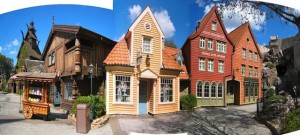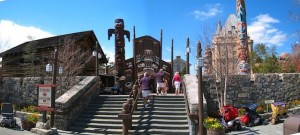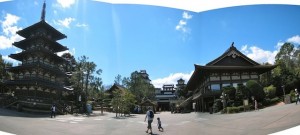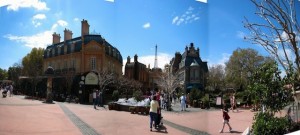Samland Visits World Showcase in Epcot
Last week, you got the Samland view of Future World. This week I take a stroll around the lagoon and visit the World Showcase.
So how do you bring peace and harmony to the world? The formula at the World Showcase is to host countries in a suburban-like cul-de-sac around a lagoon and give each country the same amount of waterfront footage. Use a design trick called “shrink and edit” on vernacular architecture and then populate the pavilions with residents from the host country. The idea came from Imagineer Harper Goff, Art Director for 20,000 Leagues Under The Sea and designer of Disneyland’s Jungle Cruise and City Hall.
Each pavilion tries to capture the essence of one country and create a sense of place. Instead of being a collection of exact replicas of famous buildings, the Imagineers use a cinematic trick called “shrink and edit”. This technique takes well-known iconic buildings, changes the scale and some of the details, and then arranges the structures to make the most compelling composition.
The architectural aficionado is going to have a field day as you stroll the 1.3-mile promenade around the lagoon. Going clockwise you start with an Aztec-style pyramid with a Mexican village tucked inside. Next-door, a Norwegian castle and village is out front with its Stave Church and sod roofs. A scale model of 1420 Hall of Pray for Good Harvest dominates China while Germany heavily leans on Bavarian influences. In Italy, the reproduction of Venice’s Piazza of San Marco is reversed.
The American Adventure’s Georgian manor uses forced-perspective to hide the huge show building and to make the structure look smaller than it really is. The traditional torii gate along the waterfront and the 83-foot pagoda outside the entrance of a palace defines the Japan pavilion. The King of Morocco brought over his own artists to create the amazing hand-made terra-cotta tile mosaics that line the rooms and corridors that connect the ville novelle section to the Median section.
France celebrates the La Belle Époque (Beautiful Age) period and includes a 1/10th scale model of the Eiffel tower. A replica of the long-gone Pon des Arts Bridge connects France to the United Kingdom. The UK pavilion is a history lesson in British architecture and includes examples of Elizabethan, Tudor, Regency, Yorkshire, and Victorian buildings plus a Shakespearian cottage. Finally, Canada presents nothing less than the Rockies and one of that country’s most famous gardens.








